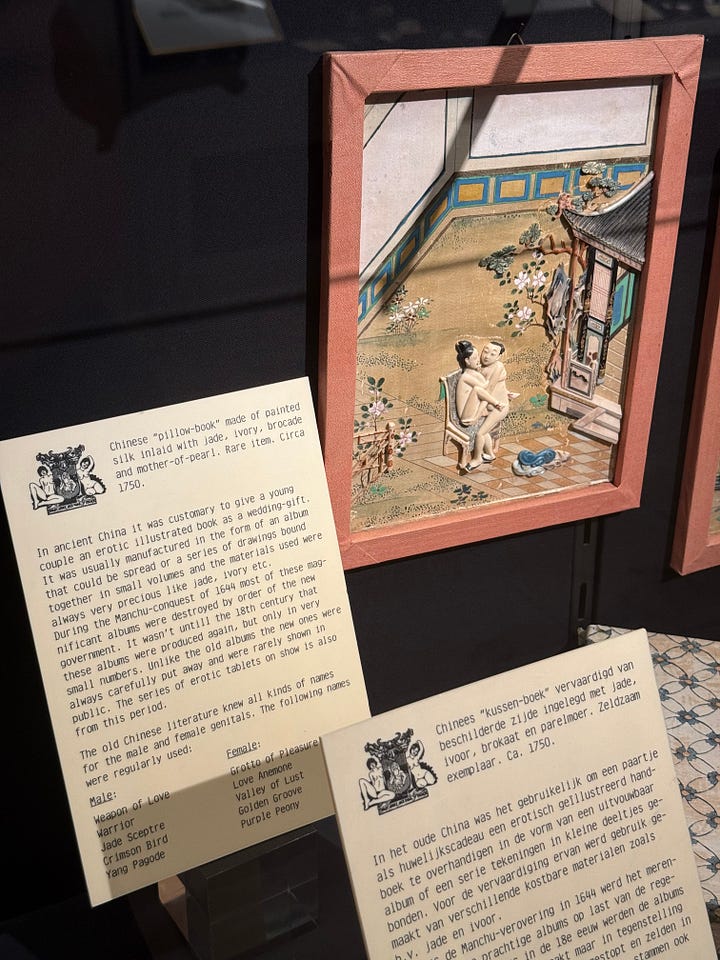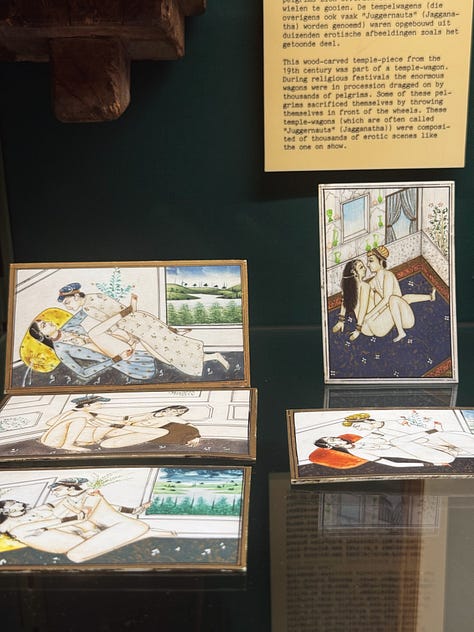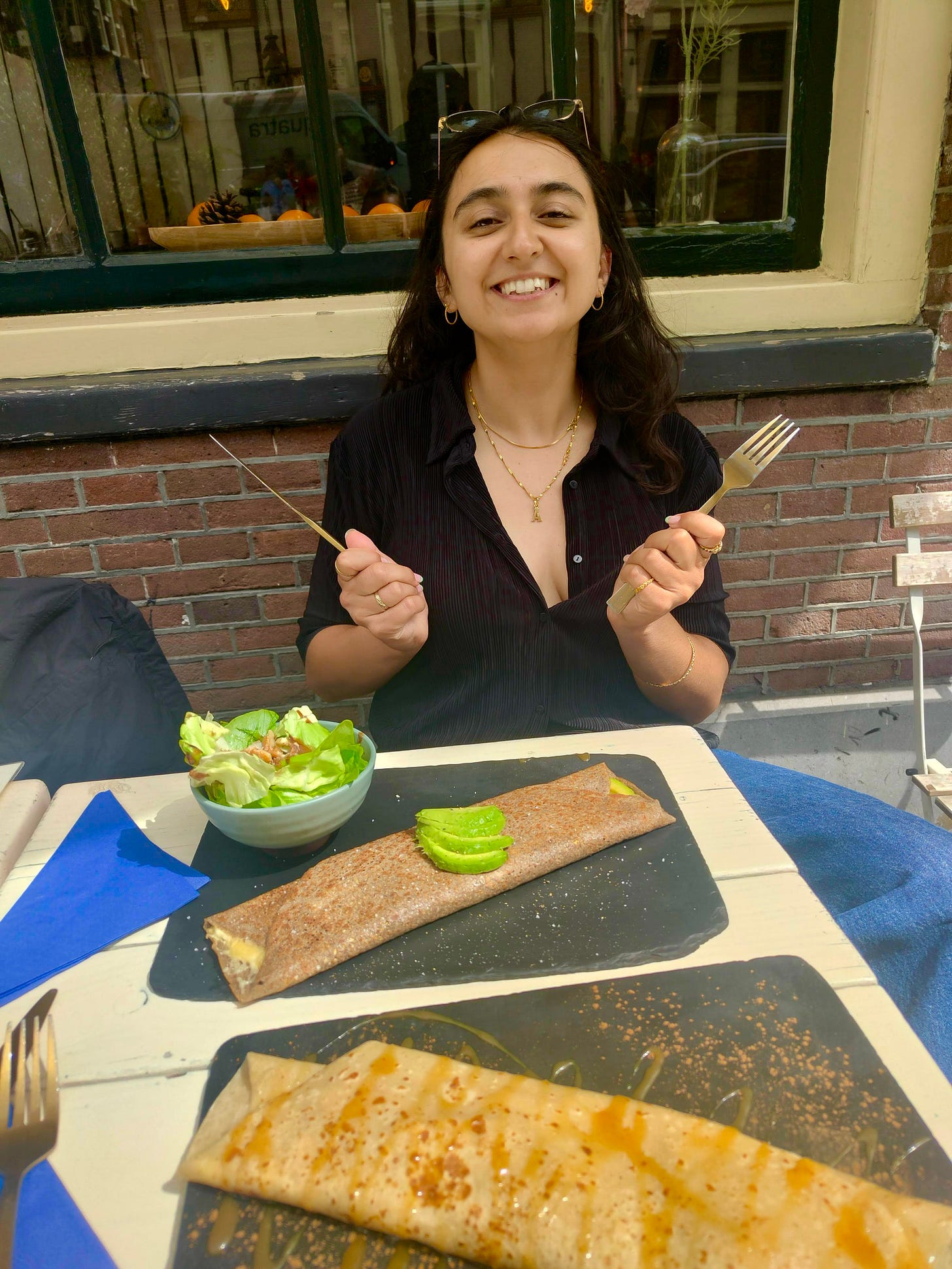Special Dispatch: Amsterdam
A one star review
Last weekend, I was sweating buckets on the streets of Amsterdam. Aside from probably having heat stroke and getting ridiculous bloating from the gluten I like to pretend I’m not allergic to, I had the best time.
This is the first time I feel like I’ve properly explored the city. That might have to do with the fact I’ve not had to hide from the standard wet and dreary weather this city has served up for me in the past, or because I’ve been staying with one of my besties who knows the city well. Or, maybe, it’s that this is the first time I’ve visited since starting Brown Bodies, and that that lens is a fascinating one to explore the city through. I’m here with ‘Go to the sex museum’ at the top of my to do list, closely followed by ‘Find buckwheat pancakes’. The buckwheat pancakes were fantastic. The sex museum? Not so much.
Trigger warning: there are mentions of sexual violence and rape below.
Sexmuseum Amsterdam
I spend the two hours I’m at the museum wondering what the point of the place is. Is it an accessible way to educate? A tourist gimmick? A place to archive sex in art? A jokey photo opportunity?
From the moment I walk in, I hate the place. I get my €10 ticket, walk through the turnstiles and am hit with the moans and groans of a life size, sex worker mannequin giving a suited old man a hand job. I think it’s meant to make me laugh? Across from it, rather incongruously, sit wall to wall glass displays housing art from across the world. It starts with pencil drawings from Western Europe from the 19th and 20th century. Honestly? I feel a bit sick at the violence against women depicted: women being subjected to sexual violence as a form of torture, a naked woman dangling from her feet, women being penetrated by the devil… and there’s no written explanation to go alongside it. You have no idea what the context is meant to be. Are these meant to be erotic? Are they condoning this behaviour? Where is the trigger warning for the depiction of rape? Or the explanation that in Christian Europe, women’s sexuality was heavily policed — virginity, chastity, etc were moral ideals and women having sex in art is often depicted as something unnatural or sinful — which would explain the devil imagery.
Some young boys, I’m guessing in their late teens (the older I get, the worse I am at guesstimating anyone under 25), are next to me while I’m looking at this section. I’ll give it to them, they’re taking it pretty seriously but I wish they’d been given more to work with. Do they know what they’re looking at? Does this stuff turn them on? What a wasted opportunity to not start a conversation around men and masculinity in these displays.
It gets better a little further down as I reach the Indian subcontinent display. In the art from late 19th and early 20th century India, women are comfortable — even if in pretty acrobatic positions that would require me to double up on my yoga practice! They’ve got cushions behind them or under them. They’re supported by their partner. There’s clearly pleasure on their faces. It fascinates me that in almost the entire museum this is the only place where sex is depicted as an act of love and intimacy. The other exceptions are the Japanese and Chinese erotica on the top floor.


The Kama Sutra section is also one of the only places in the entire museum where women are being pleasured, not just men. Insane.



I hear myself asking why is it that we look to the west as the absolute pinnacle of sexual liberation and pleasure when some of our cultures have had this ingrained for centuries? I’m frustrated at the lack of context around colonial destruction of pleasure in the name of control and religion. There’s a lot of literature out there about how the colonial machine shrouded the Indian subcontinent in shame under the guise of Victorian era sensibilities of ‘decency’. A really good example that my friend Nishad writes about here is the Tawaifs. They were ‘Courtesans, artists, patrons of culture, and significant contributors to the Mughal treasury until Victorian morality reduced them to the word “prostitute” — the very women who bankrolled the first war of independence in 1857.’ The impact on the taboofication of sex is still felt today. So, to have this gorgeous art without the understanding of the devastating loss of culture upsets me. It’s not only a disservice, it’s an extension of exotic voyeurism — cultural artefacts are stripped of meaning and repackaged for consumption without reckoning with the violence that made them available to this museum in the first place.
I’m not saying that pre colonialism there weren’t issues around sex. Of course there were! There was a lot of mess when it came to class, religion, political divide, empires pre the British, sex as a weapon, marriages as a political tool, etc. I shouldn’t even have to caveat this. We barely do that with western sexual history. We don’t say, ‘Oh hey, the 80s were all about sexual liberation but did you know Black and South Asian women were sometimes given long-acting or irreversible contraception, sometimes without consent?’ Blurgh.
I actually feel angry at the museum’s lack of articulation around racism in general. Like don’t get me started on the display on the top floor of Josephine Baker — a Black dancer and activist from the 1920s who performed across Europe in a banana skirt. Her costume obviously played into colonial exoticism but there’s a lot of reading around how she used it to dispel stereotypes. She was a voice in the civil rights movement, spoke alongside Martin Luther King Jr. at the March on Washington and refused to perform for segregated audiences. Where was that context in the museum?
One of the things I’d seen on TikTok was about the Sexmuseum’s vision on the future of sex. Firstly, dear TikToker, where was this? Because if you were talking about the ‘3D’ (it’s really not) film that looks at sex through the ages, then you’re a top tier comedian. For those of you who’ve not been, the Sexmuseum’s conclusion is, ‘We don’t know what’s going to happen but here’s a male robot groping a woman’s boobs. How exciting the future of pleasure is going to be!’
I could go on but I won’t. It’s fair to say, I do not recommend. I think the place is everything that alienates me from a lot of the ‘sex scene’ stuff that currently exists. It’s not that I’m prudish (lol), it’s that the shock factor feels unnecessary, there is a lack of acknowledgement of racism and sexism, and the conflation of sex and pornography makes me uncomfortable. I was hoping for insight, history and inclusivity, and I got a spectacle.
So, for your next Amsterdam trip, here’s what I recommend you do instead:
The Oh Collective store. Founded by four Asian women, you can find this sex store in the heart of Amsterdam. It has excellent (safe) products, events, and the team is just lovely. Everything is well researched which is more than you can say for a bunch of stores in the city. I bought myself a €20 surprise bag and was not disappointed. When I finally get through my Amsterdam photos and videos, I’ll do an IG reveal.
Rijksmuseum. I’ve not been but I’ve heard good reviews about their current Indian subcontinent photography exhibition and the Asian Pavilion. If you do go, let us know how it was!
Secondhand bookstores. For English secondhand books head to Sterre der Zee and The Book Exchange. Both had a good collection of spirituality, love, and sex focused books — fiction and non-fiction. There were also a lot more South Asian authors than I expected to see at both. Don’t ask me how much time I spent in them or how many books I came home with, thanks.
Oh and I’m not gatekeeping… The buckwheat pancakes I had were from here. And all the other places I went to (and didn’t hate!) are here.
PS. I didn’t send my last Brown Bodies article out as an email, so if you haven’t read it and want a bonus read for this week…:
An ode to the summer romance
Summer’s here. Maybe it’s because I like myself more in the sun (to be honest, I like everyone else more in the sun, too) but I’ve let my mind wander to the magical notion that is a summer romance. I’m a sucker for summer love. The thoughts of heartbreak and despair? Long gone. Summer brings about renewed hope. A new love in the sun. Clammy nights with …




